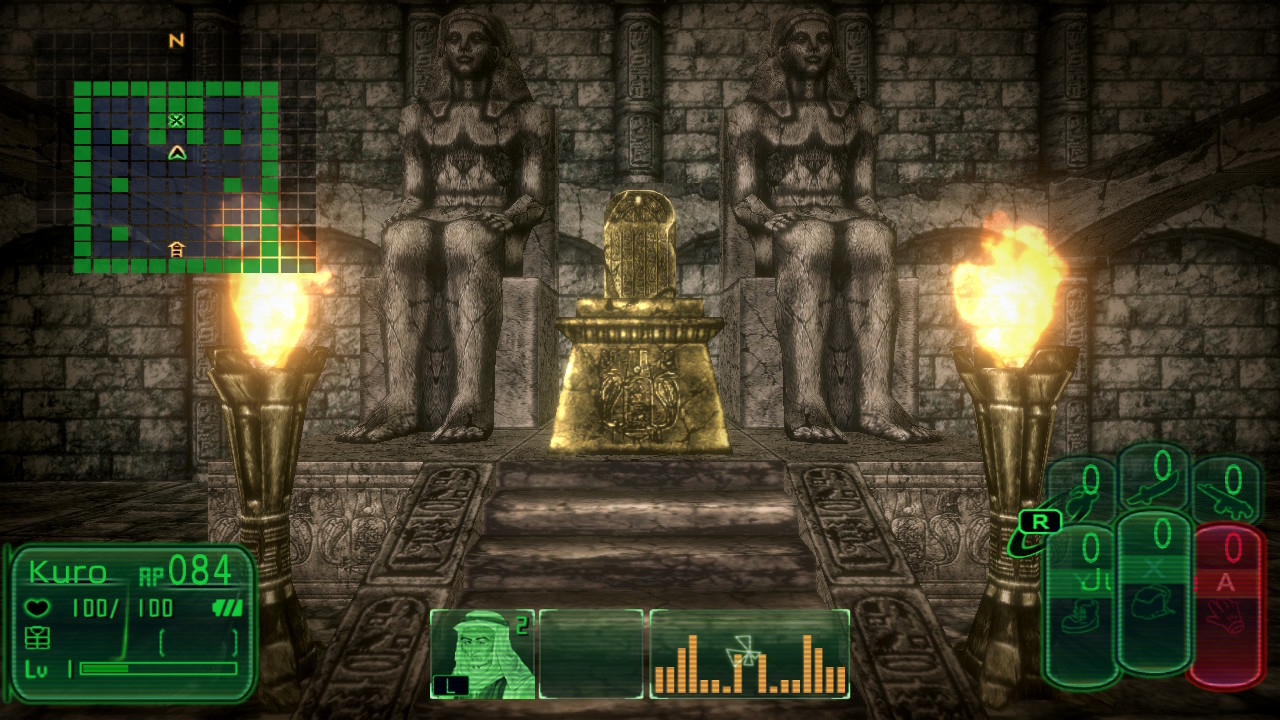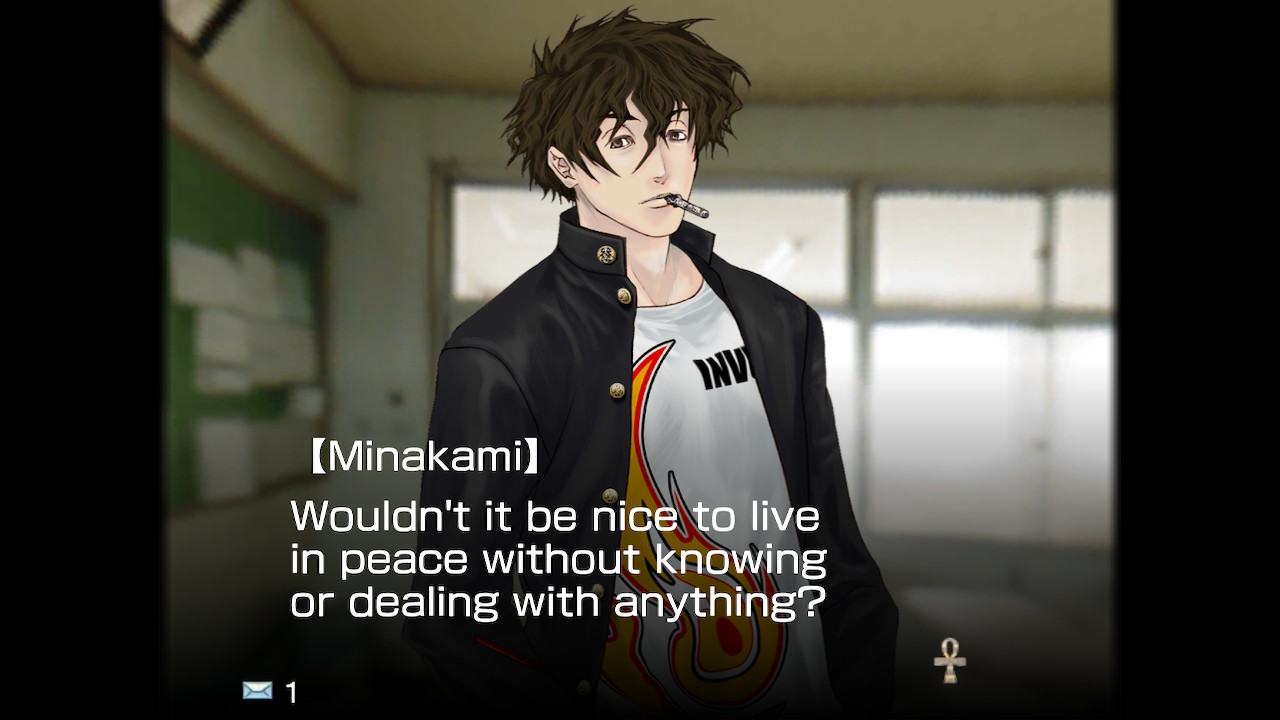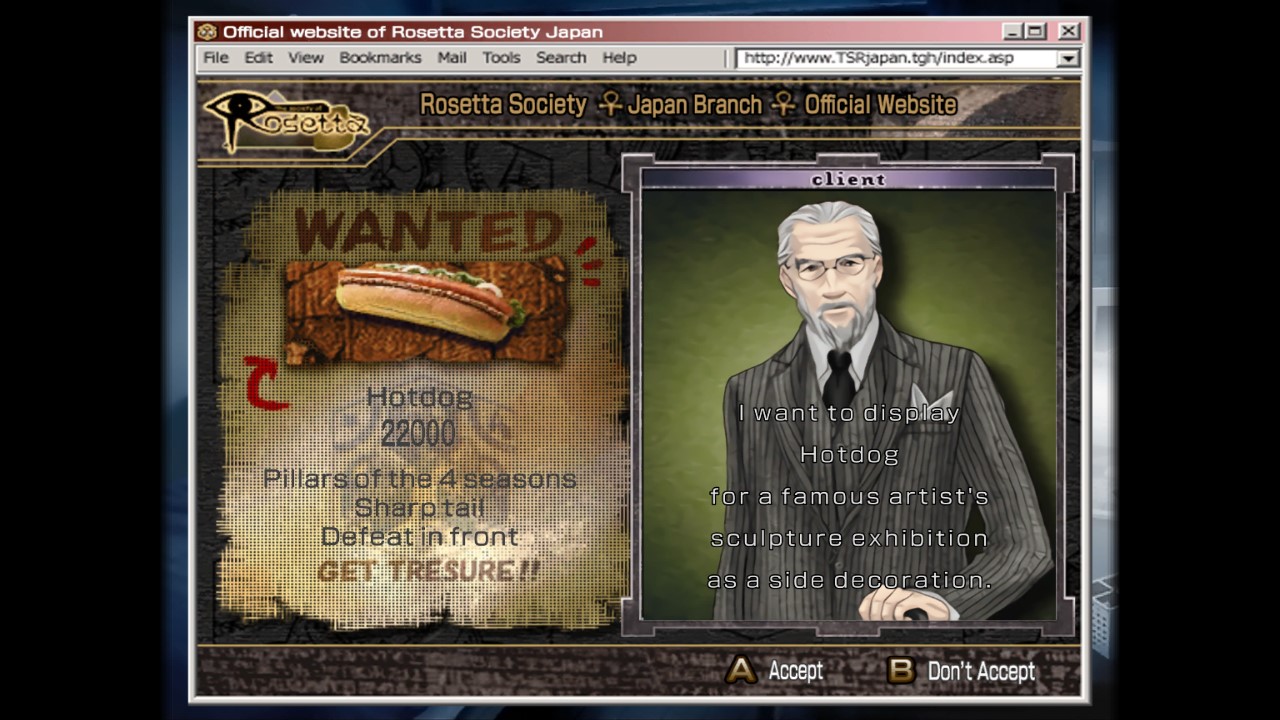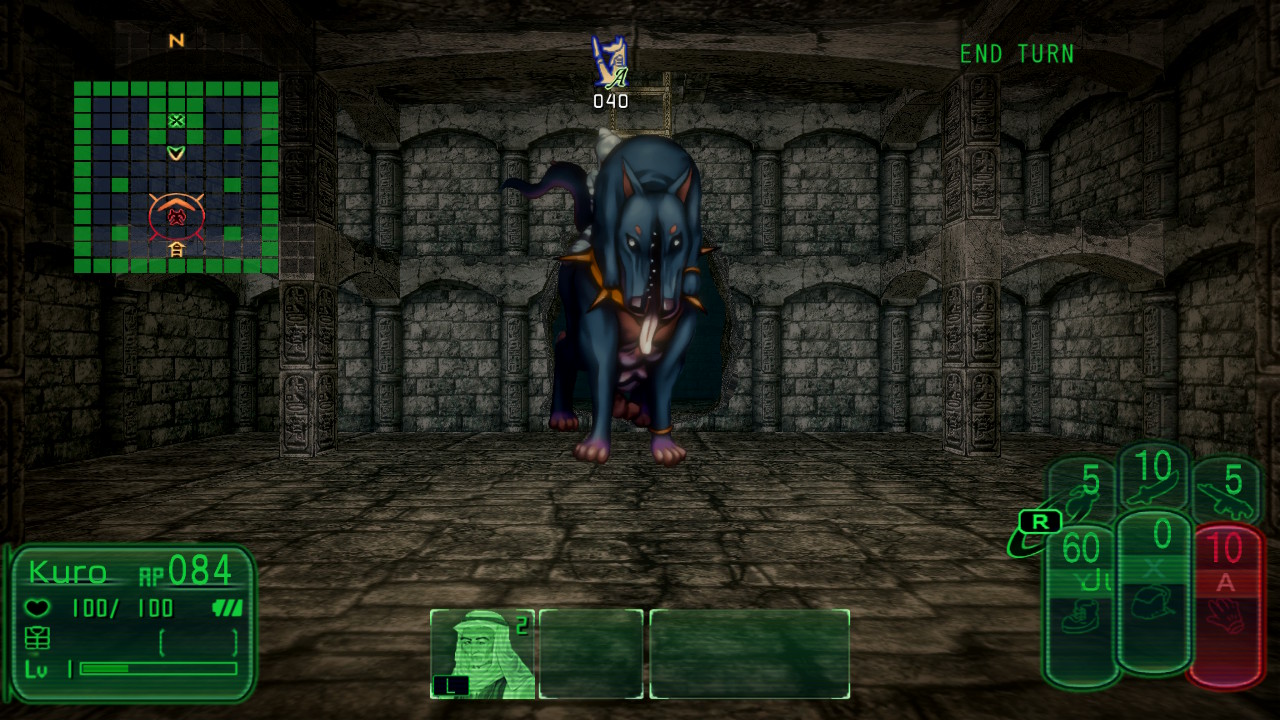“An unpolished gem will never be a treasure.” –The Book of Rites
Kowloon High-School Chronicle debuted on the PlayStation 2 in Japan in 2004 and has finally made its way to the rest of the world. In this odd mix of visual novel and old-school dungeon crawl, you’re a treasure hunter like that guy named after one of the United States who’s always jonesing for more adventures. Fresh from archaeological success in Egypt, your next assignment from the Rosetta Society espionage agency sends you to Kamiyoshi Academy boarding school in Shinjuku, Japan (not Kowloon, which is in China), where you race the evil Relic Dawn organization to locate an ancient relic deep beneath the school’s cemetery. Why a high school would need its own cemetery raises questions, and you’re looking for answers, going undercover as a student in a graveyard grift. Does something sound a bit wrong about that?
It doesn’t sit right that your character, who’s apparently a grown man, is going “undercover” at a high school. It’s possible he’s an Akechian (I’m inventing Persona 5-based words) teenage prodigy who just so happens to be so accomplished that he’s a professional in his field while still in high school. But there’s nothing to indicate this guy’s age. Presumably, he’s young enough that he thinks he can believably pass as a student. But when he is inevitably discovered by several of his classmates, it’s a “how do you do fellow kids?” moment. The game is not really a dating sim, but it is uncomfortable when characters express their romantic interest and you’re expected to respond. It would have been easy to avoid the game’s questionable setup by clarifying that the main character is also a teenage student, but that is never communicated.
Looking past that issue, Kowloon High-School Chronicle presents some interesting twists on typical RPG conventions. The unlikely combo of visual novel and dungeon crawl makes for a surprisingly harmonious partnership, and you should wish them a long and happy life together. During the visual novel portions, you spend your school day cultivating relationships with students and faculty, whom you try to charm enough to go with you into the spooky cemetery at night after class. That’s where the dungeon crawl comes in and where you spend the majority of your time.
Beyond the struggles of an adult trying to fit into a school uniform, as a “student,” you also must contend with the authoritarian Student Council that guards the cemetery, vowing death to any who enter. Of course, the entire reason you’re here is at odds with that strict policy, so you’re probably not going to get along too well with those meanies. Dark forces also inhabit the ruins, which you will surely disturb. You also learn there’s a strange connection between Japan and ancient Egypt, not the least of which is that the ruins are in the shape of an upside-down pyramid.

Each chapter of the story features a monster-of-the-week setup, where you come into conflict with a new student rival, which inevitably leads to a fight, each taking place deeper inside the cemetery ruins than the last. Despite standard horror tropes, some of these side story beats are emotionally affecting, including helping a guy whose sister died move on instead of violently lashing out at other students and convincing a teenage samurai that seppuku isn’t necessary after losing a fight to you. The main story takes a while to get going. The bits of Japanese mythology and its bizarre connections to ancient Egyptian lore and the other paranormal pseudoarchaeology encompassed here are fascinating, but their ties to the main story are awkward. So much of the narrative is shrouded in mystery that when “answers” reveal themselves toward the end, everything that came before it feels inconsequential. And here I’d thought we were long past those ridiculous M. Night Shyamalan plot twists.
The visual novel portion mainly progresses in the standard manner, but with a few quirks. When a character poses a question, you occasionally have the typical multiple-choice list of responses. But most of the time, you are instead given a wheel of eight different responses to choose from based on emotions, or you can not respond at all. For instance, if a character asks how you feel about books, you could respond with Joy or Anger. It’s an intriguing concept, but its implementation might not justify its existence. Though you can have fun giving off-the-wall answers all the time, you generally want to get the characters to like you enough to join you as companions when you go exploring, so it often feels like choosing the “right” response is your goal over proper role-playing.
Though characters generally fall into high-school anime stereotypes, most offer twists on those tropes that make them feel original enough. There’s your athletic best friend, Yachiho, who is a girl (in a reversal of gender tropes). Minakami is the slacker, but he’s a deep thinker instead of thick-headed and he smokes lavender cigarettes. Much like the cemetery, you will find there’s more to these characters beneath the surface.

As in traditional dungeon crawlers, you explore square by square as you try to get to the bottom of the ruins. There are some novel differences, though. Instead of random battles, you encounter monsters in certain rooms. Once you’ve cleared the room, you’re free to explore it. In combat, the Action Points system gives you freedom in making your moves and feels more engaging than move-and-attack schemes in similar games. Though it’s more involved, puzzling out the most effective use of your turns makes for a nice challenge. Fights take on a tactical feel as you try to balance moving around enough to avoid enemies’ devastating attacks and getting in enough hits of your own. I can’t emphasize enough how much you should avoid being hit, as harmful status effects from hits do much nastier things than just dropping your HP. If you’re inflicted with blindness, the screen goes completely dark. There are also “adventure” sequences that sort of behave like battles, which should make any Indiana Jones fan feel as though they’ve properly donned his fedora. In one, there are spikes on the ceiling which lower each turn, threatening to skewer you; in another, you’re in danger of being flattened by a giant rolling boulder.
You take two friends with you into the dungeon. They don’t participate in the way traditional companions would, but instead offer special abilities and stat buffs/debuffs. The abilities are fun to play with, as they usually stem from aspects of the characters’ personalities. For example, Yachiho’s extracurricular school activity is tennis, so her active special ability is smacking a tennis ball at enemies (with an animation of a ball hitting them). Her passive ability, called “Return,” sends enemy projectiles back at them as a counterattack. Nanako, a waitress, flings hot pizzas at monsters, which can cause burns. You might call in Nanase, the bookworm and history buff, when you need hieroglyphics translated, though her physical weakness means she’s no good for your combat plans. Your friends’ characterization continuing into the dungeon makes them feel like actual people, rather than just packs of abilities and stats, and it connects the dungeon crawl to the visual novel. It was also bizarrely fun to soften my enemies up with my assault rifle before finishing them off with a torrent of tennis balls. There appear to be 24 characters you can recruit, so there are plenty of potential options, though not all of them will join your crew. As someone who generally has low interest in visual novels, if more of them implemented a substantial “other half” like the dungeon crawl in this game, I might play more of them.
There’s an amusing emphasis on mundane items you might find lying around in a school that you need to make use of. What should you do with that aluminum foil or tissues? Crafting is not elaborate, as you simply combine two items to create a new one, like mixing detergent with window cleaner to make fire suppressant. For healing, you eat common foods. You can eat the raw fish, but it will restore more HP if you combine it with vegetable oil to make fried fish, which you can further improve by adding a root vegetable to yield fish and chips. It makes sense that, if you plan on eating that raw horse meat you found lying around in ancient ruins, you should at least cook it before you eat it.
There is some grind, though there’s more to it than just needing to be stronger in combat. There are dozens of upgradable abilities on your character’s stat sheet (smartly styled like a school report card), some of which offer boosts in combat and some, like lockpicking and reading hieroglyphics, that are necessary to advance while exploring. So, despite having a host of abilities to choose from, you’re basically forced into investing in specific ones. Still, dealing with enemies usually has more to do with good planning than higher stats. But also, to fund your adventures, your only means of making money is through requests from the Pierce Brosnan-looking British museum curator who wants you to find a hamburger that he can show off in an exhibit or the Japanese minister who wants you to bring him eggs, which he intends to use as leverage in a political deal. Surely people of that stature could afford their own hamburgers and eggs, but hey, a gig is a gig. The side quests can be fun and help immerse you in the life of a poor adventurer pandering for funding. But there’s already plenty for players to do, and not giving players money for defeating enemies feels harsh.

Bosses can be brutal. While leveling up is needed to a certain point, you won’t win without devising a good strategy and exploiting their weakness. That’s much more intriguing than simply needing better stats, and they are varied enough to keep the fights interesting. It can take a lot of trial and error and tinkering with your strategy, and your execution must be flawless. The game doesn’t have a homework simulator, but the amount of planning it takes to get through some of the later boss battles feels pretty close. As it will probably take a few tries to beat many of them, the game shows its age: you must repeatedly sit through the cutscenes to get to the fight, though developers at least added a fast-forward option. But there’s satisfaction in cracking that code and finally getting the victory, much like a Souls game. You can switch difficulties at any time, but even on Easy, the challenge is still extreme.
The control scheme is unique, but not in a good way. You have two stances, which you can switch between with a button press. The only difference is the non-standard stance gives you access to your combat actions. It’s probably not any more or less elegant than choosing actions from a menu, but such an unfamiliar setup makes the interface awkward, especially for a turn-based game. A menu would have been fine.
Though the controls are rough, the sounds of Kowloon High-School Chronicle are silky smooth. From hot, jazzy numbers to slower, walking-bass, tobacco smoke-filled lounge music and slow, slinky piano ballads, it feels like James Bond could sneak in, martini glass in hand, at any moment. The voice acting is energetic and emotive, and the voices pair well with the character drawings, though dialogue is Japanese only. The game’s sense of style is relentless. Each chapter is stylized like an anime TV series, complete with an intro, end credits, and a commercial screen when moving between activities. The game is simply too cool for this world. Jojo referenced this game, not the other way around. Don’t get it confused.
The game shows off its personality in its appearance too. Characters have a hand-drawn look that avoids typical anime conventions. During the story, the backgrounds are simply blurry photographs, making for a strange and appropriately unsettling appearance that jives with the game’s horror/mystery themes. Inside the ruins, you get those classic PS2 3-D graphics with environments varied enough to keep exploration lively. One section is like a jungle with trees, and another looks like you’re inside a volcano. Statues and other structures contribute to that Lucasfilm flare the game is not shy about chasing after.

Despite heavily referencing a 40-year-old movie franchise, the Indiana Jones stylings boldly announced with the game’s red-and-yellow title fonts still feel fresh and are especially unique to RPGs. Gamers generally turn to Tomb Raider and Uncharted for their archaeological adventuring. For a similar RPG fix, the Grandia series might be the closest comparison, but the latest release in that series was Grandia III, which came out just a year after Kowloon High-School Chronicle’s original debut.
The premise, again, is questionable at best, and making friends with characters can be uncomfortable, especially with the romantic overtones. There are many suggestive moments throughout the game too. Perhaps the worst offender is a story about a peeping tom that somehow also manages to take a transphobic turn. Another character at the school is going undercover (much like you) as a private investigator and gets chased off whenever students or teachers see him because he’s a creep. It feels worse that these situations are intended to be comedic. This sex pest vibe is pervasive enough that, combined with the high-school espionage, many will choose to steer clear of this game. That’s especially true as cultures across the world are currently figuring out how to deal with sexual abuse in many forms.
It’s too bad because the positive things this game does with its gameplay, characters, and how those elements interact with one another are impressive, innovative design and could easily be scooped out of this game and dropped into a much more agreeable story. But the premise and the all-around gross vibe drag down Kowloon High-School Chronicle. There is fun to be had if you’re willing to wade through the muck, but some people just won’t want to. The game’s director Akiyoshi Imai and producer Juzo Kanazawa have indicated they are considering a sequel, and this new release, in part, is intended to gauge interest for a sequel. There’s still a lot of potential for that, though hopefully there would be substantial changes in their approach to the story. But the creepiness wasn’t OK in 2004, and it feels completely out of place in 2021. This “gem” needed more polish to become the treasure that it could have been for modern audiences.


